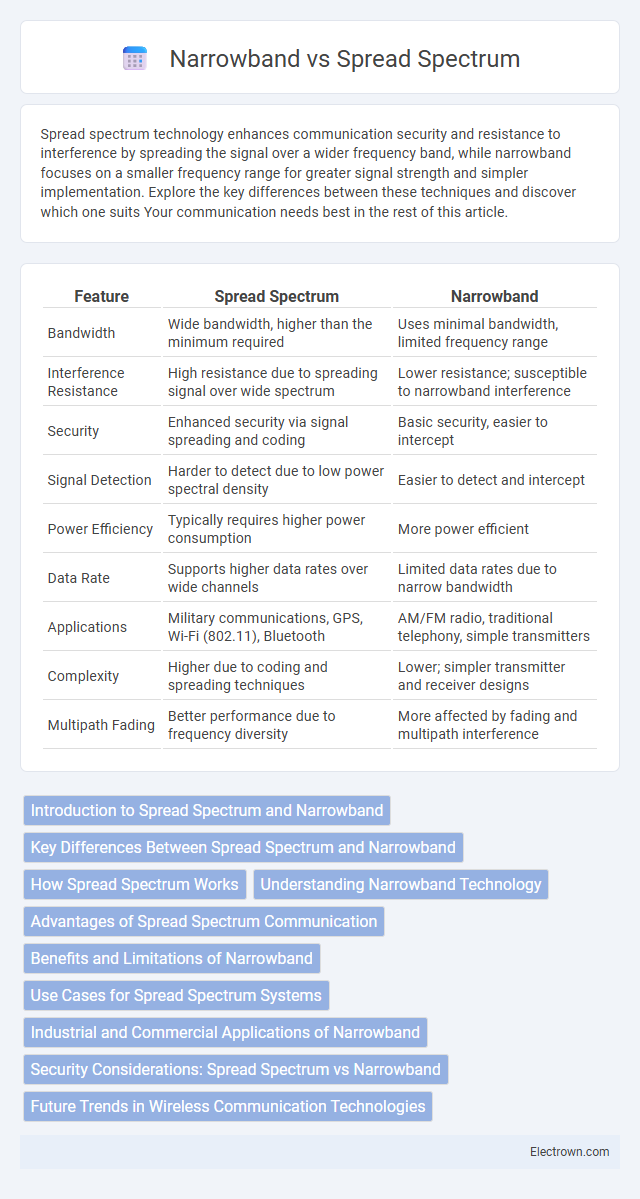Spread spectrum technology enhances communication security and resistance to interference by spreading the signal over a wider frequency band, while narrowband focuses on a smaller frequency range for greater signal strength and simpler implementation. Explore the key differences between these techniques and discover which one suits Your communication needs best in the rest of this article.
Table of Comparison
| Feature | Spread Spectrum | Narrowband |
|---|---|---|
| Bandwidth | Wide bandwidth, higher than the minimum required | Uses minimal bandwidth, limited frequency range |
| Interference Resistance | High resistance due to spreading signal over wide spectrum | Lower resistance; susceptible to narrowband interference |
| Security | Enhanced security via signal spreading and coding | Basic security, easier to intercept |
| Signal Detection | Harder to detect due to low power spectral density | Easier to detect and intercept |
| Power Efficiency | Typically requires higher power consumption | More power efficient |
| Data Rate | Supports higher data rates over wide channels | Limited data rates due to narrow bandwidth |
| Applications | Military communications, GPS, Wi-Fi (802.11), Bluetooth | AM/FM radio, traditional telephony, simple transmitters |
| Complexity | Higher due to coding and spreading techniques | Lower; simpler transmitter and receiver designs |
| Multipath Fading | Better performance due to frequency diversity | More affected by fading and multipath interference |
Introduction to Spread Spectrum and Narrowband
Spread spectrum technology transmits signals over a wide frequency range, enhancing resistance to interference, eavesdropping, and signal fading, making it ideal for secure and robust wireless communication. Narrowband systems operate within a small frequency band, offering high spectral efficiency and simpler implementation but are more susceptible to interference and noise. Understanding the fundamental differences between spread spectrum and narrowband is crucial for selecting appropriate communication methods in various wireless applications.
Key Differences Between Spread Spectrum and Narrowband
Spread spectrum transmits signals over a wide frequency band, enhancing resistance to interference, eavesdropping, and multipath fading, while narrowband concentrates energy on a single, narrow frequency band, offering higher spectral efficiency and simpler receiver design. Spread spectrum techniques include Frequency Hopping Spread Spectrum (FHSS) and Direct Sequence Spread Spectrum (DSSS), which provide robustness in noisy environments but require more complex synchronization. Narrowband communication suits applications with fixed channels and low interference, whereas spread spectrum excels in secure and interference-prone wireless systems.
How Spread Spectrum Works
Spread spectrum works by distributing a signal across a wider frequency band than the original data rate requires, enhancing resistance to interference and eavesdropping. Techniques like Direct Sequence Spread Spectrum (DSSS) multiply the data signal by a pseudorandom noise code, effectively spreading the signal over a broad spectrum. This method allows your communication to maintain reliability and security even in environments with significant noise or jamming attempts, unlike narrowband systems that transmit over a limited frequency range.
Understanding Narrowband Technology
Narrowband technology utilizes limited frequency bandwidth, typically under 25 kHz, to transmit signals with higher power spectral density, resulting in efficient long-distance communication and reduced interference in congested environments. It is ideal for applications such as two-way radios, telemetry, and IoT devices where clear, reliable voice or data transmission is crucial. Your choice of narrowband communication enhances signal clarity and spectral efficiency, particularly in settings demanding minimal adjacent channel interference.
Advantages of Spread Spectrum Communication
Spread spectrum communication offers enhanced resistance to interference and jamming, making your signal more secure and reliable in hostile environments. It provides better privacy through low probability of interception and reduces multipath fading, improving overall signal quality. This technology supports multiple users simultaneously by spreading the signal across a wide frequency band, effectively minimizing cross-talk and interference.
Benefits and Limitations of Narrowband
Narrowband communication offers benefits such as better signal clarity, lower power consumption, and improved range in environments with minimal interference. Its limitations include reduced data rates and vulnerability to narrowband interference, making it less suitable for high-bandwidth applications. You should consider narrowband for reliable, low-power transmissions where bandwidth efficiency is prioritized.
Use Cases for Spread Spectrum Systems
Spread spectrum systems are ideal for military communications, where resistance to jamming and interception is crucial. They are also used in wireless networking technologies like Wi-Fi and Bluetooth to improve security and reduce interference. Furthermore, spread spectrum techniques benefit GPS signals by enhancing signal robustness and accuracy in challenging environments.
Industrial and Commercial Applications of Narrowband
Narrowband communication systems are widely utilized in industrial automation and commercial telemetry due to their high spectral efficiency and robust interference resistance. These systems enable precise control and monitoring of machinery, supporting applications such as SCADA networks and smart metering with minimal bandwidth and power consumption. Their reliable performance in harsh RF environments makes them ideal for industries requiring secure, long-range connectivity and low latency data transmission.
Security Considerations: Spread Spectrum vs Narrowband
Spread Spectrum communication offers enhanced security through its inherent resistance to eavesdropping and jamming by spreading the signal across a wide frequency range, making unauthorized interception more difficult compared to Narrowband systems. Narrowband signals, confined to a narrow frequency band, are more vulnerable to intentional interference and signal interception due to their predictable and concentrated frequency usage. When securing your communications, Spread Spectrum techniques provide a stronger defense against interception and signal disruption, ensuring more robust privacy and operational integrity.
Future Trends in Wireless Communication Technologies
Future wireless communication trends emphasize the integration of spread spectrum techniques to enhance security and interference resistance, especially in dense network environments. Narrowband technologies are evolving to support ultra-low power and long-range IoT applications, with advancements in NB-IoT and LTE-M standards driving efficient spectrum utilization. Your choice between spread spectrum and narrowband will increasingly depend on the specific application requirements for bandwidth, latency, and energy efficiency.
Spread Spectrum vs Narrowband Infographic

 electrown.com
electrown.com